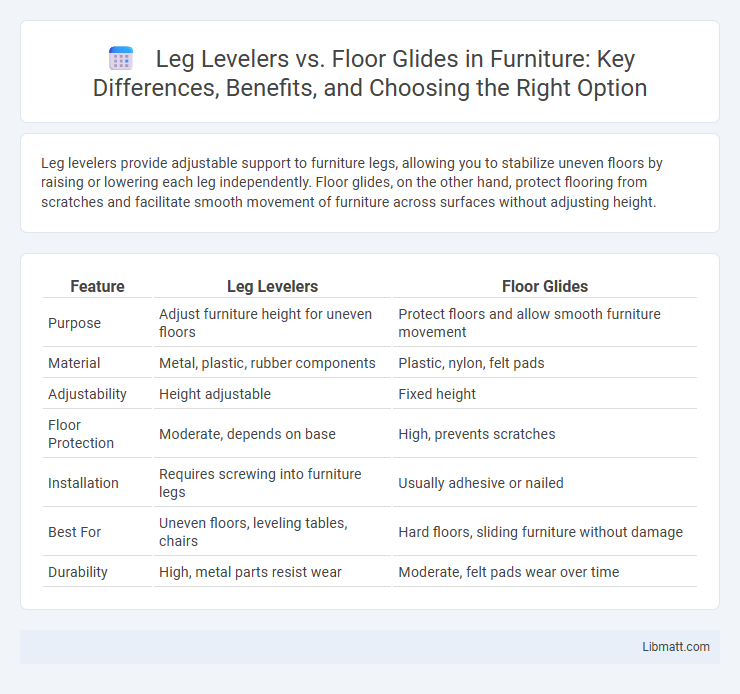Leg levelers provide adjustable support to furniture legs, allowing you to stabilize uneven floors by raising or lowering each leg independently. Floor glides, on the other hand, protect flooring from scratches and facilitate smooth movement of furniture across surfaces without adjusting height.
Table of Comparison
| Feature | Leg Levelers | Floor Glides |
|---|---|---|
| Purpose | Adjust furniture height for uneven floors | Protect floors and allow smooth furniture movement |
| Material | Metal, plastic, rubber components | Plastic, nylon, felt pads |
| Adjustability | Height adjustable | Fixed height |
| Floor Protection | Moderate, depends on base | High, prevents scratches |
| Installation | Requires screwing into furniture legs | Usually adhesive or nailed |
| Best For | Uneven floors, leveling tables, chairs | Hard floors, sliding furniture without damage |
| Durability | High, metal parts resist wear | Moderate, felt pads wear over time |
Introduction to Leg Levelers and Floor Glides
Leg levelers and floor glides are essential hardware components designed to improve furniture stability and protect flooring surfaces. Leg levelers feature adjustable screws that allow precise height alteration to compensate for uneven floors, maintaining balance and preventing wobbling. Floor glides, often made of felt or plastic, provide a smooth surface beneath furniture legs, enabling easier movement while minimizing scratches on hardwood, tile, or laminate floors.
Purpose and Functionality
Leg levelers provide adjustable height support to furniture on uneven surfaces, ensuring stability by compensating for floor irregularities. Floor glides primarily protect floors from scratches and facilitate smooth movement of furniture while offering minimal height adjustment. Choosing between leg levelers and floor glides depends on whether your priority is precise leveling or floor protection and ease of furniture repositioning.
Material Composition Comparison
Leg levelers are typically composed of metal components, such as steel or aluminum, combined with durable plastic or rubber bases to provide height adjustment and stability on uneven floors. Floor glides usually feature a simpler material composition, often consisting of molded plastic or nylon with felt or rubber pads to allow smooth movement and protect flooring surfaces. The use of metal in leg levelers offers greater strength and adjustable functionality, while floor glides prioritize ease of sliding and floor protection with lighter materials.
Installation Process Differences
Leg levelers require screwing into the bottom of furniture legs, making installation more involved and suitable for adjustable height needs. Floor glides simply snap or slide onto legs, offering a quicker, tool-free installation but lacking height adjustability. The mounting hardware and method for leg levelers demand more precision, while floor glides prioritize ease and speed.
Weight Capacity and Stability
Leg levelers typically offer higher weight capacity and enhanced stability due to their adjustable threaded design, which allows precise height customization on uneven surfaces. Floor glides provide moderate weight support and stability, best suited for lighter furniture and smooth floors, as they prevent scratching but lack the fine-tuning ability of leg levelers. For heavy-duty applications requiring maximum steadiness, leg levelers outperform floor glides by accommodating substantial loads while maintaining balanced support.
Surface Compatibility
Leg levelers offer precise height adjustment and work best on uneven or carpeted surfaces, ensuring stability by compensating for flooring irregularities. Floor glides are ideal for hard surfaces like hardwood, tile, or laminate, preventing scratches and allowing smooth furniture movement. Choosing the right option depends on your floor type to maximize protection and functionality.
Maintenance and Longevity
Leg levelers provide adjustable support that reduces wear on furniture legs by preventing wobbling, thereby extending the furniture's lifespan with minimal maintenance required. Floor glides, typically made of durable materials like nylon or felt, protect floors from scratches but may wear down faster, necessitating periodic replacement to maintain smooth movement. Choosing leg levelers enhances long-term stability and reduces repair frequency, while floor glides require ongoing upkeep to preserve floor and furniture condition.
Noise Reduction Capabilities
Leg levelers excel in noise reduction by stabilizing furniture on uneven floors, minimizing creaks and vibrations during movement. Floor glides, typically made from smooth materials like nylon or felt, reduce friction and prevent scratching but offer less effective noise dampening on irregular surfaces. For optimal noise reduction, combining leg levelers with soft floor glide pads provides superior stability and quiet operation.
Cost Considerations
Leg levelers generally cost more than floor glides due to their adjustable mechanism and durable materials designed for uneven surfaces. Floor glides are budget-friendly options ideal for protecting floors and allowing easy movement of furniture without the need for height adjustment. Your choice depends on balancing the cost with the specific functionality required for your furniture setup.
Choosing the Right Option for Your Needs
Leg levelers offer precise height adjustments to stabilize uneven flooring, making them ideal for heavy furniture or equipment requiring secure support. Floor glides provide smooth mobility and protect flooring surfaces but lack fine-tuning capabilities for leveling. Assess the need for stability versus ease of movement to determine whether leg levelers or floor glides best suit your furniture maintenance requirements.
Leg Levelers vs Floor Glides Infographic

 libmatt.com
libmatt.com